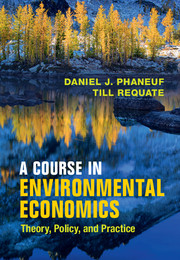Book contents
- Frontmatter
- Dedication
- Contents
- Figures
- Tables
- Preface
- Notational Conventions
- PART I ECONOMICS AND THE ENVIRONMENT
- 1 Environmental Economics and the Theory of Externalities
- 2 Environmental Problems and Policy Issues
- 3 Introduction to the Theory of Environmental Policy
- PART II THE DESIGN OF ENVIRONMENTAL POLICY
- PART III VALUING THE ENVIRONMENT
- PART IV THE PRACTICE OF ENVIRONMENTAL ECONOMICS
- References
- Author Index
- Subject Index
2 - Environmental Problems and Policy Issues
from PART I - ECONOMICS AND THE ENVIRONMENT
Published online by Cambridge University Press: 27 February 2023
- Frontmatter
- Dedication
- Contents
- Figures
- Tables
- Preface
- Notational Conventions
- PART I ECONOMICS AND THE ENVIRONMENT
- 1 Environmental Economics and the Theory of Externalities
- 2 Environmental Problems and Policy Issues
- 3 Introduction to the Theory of Environmental Policy
- PART II THE DESIGN OF ENVIRONMENTAL POLICY
- PART III VALUING THE ENVIRONMENT
- PART IV THE PRACTICE OF ENVIRONMENTAL ECONOMICS
- References
- Author Index
- Subject Index
Summary
In Chapter 1 we illustrated how the field of environmental economics has its roots in neoclassical welfare theory. From a theoretical perspective most contemporary topics in the field continue to fit into the historic paradigm of the failure of the first welfare theorem, missing markets, externalities, and public goods. Describing environmental economics in such purely theoretical terms, however, ignores the importance that practical policy issues have played and continue to play in the development of the field. Indeed research in environmental economics, perhaps more so than other fields in economics, is driven by the needs of the policy-making community.
Because of this link it is useful from the outset to understand how environmental economics developed in parallel with the growth of the environmental movement and the coming of national-level environmental policy. In the first section of this chapter we therefore provide a brief review the social, policy, and research themes from the last four decades that together helped to define the field. We follow in section 2.2 with a review of contemporary environmental problems that motivate current research, focusing on the causes and consequences of water, air, and land pollution in a variety of contexts. The environmental science discussion from this section transitions in section 2.3 to explore the relationship between economics and ecology. In both sections our review is selective and heuristic, with a focus on qualitative description rather than summarizing actual (and soon to be outdated) environmental trends. In the final section we review several policy examples in order to illustrate how the environmental and behavioral elements connect, thereby creating the need for environmental economics in policy design. These examples also provide specific context for the more abstract discussions that are used later in the book.
EVOLUTION OF ENVIRONMENTAL POLICY AND ECONOMICS
Concerns about environmental externalities are not new. For example, during the thirteenth century coal became commonly used in England as a heating fuel, and the consequences for air quality were dire enough that in 1306 King Edward I banned its use in London, albeit to little effect. Nonetheless, modern environmental awareness arose in developed countries in the 1960s as a result of the pollution consequences of the postwar economic expansion.
- Type
- Chapter
- Information
- A Course in Environmental EconomicsTheory, Policy, and Practice, pp. 17 - 34Publisher: Cambridge University PressPrint publication year: 2016



